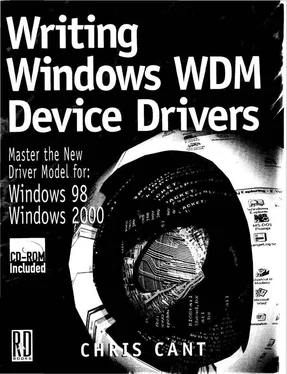Chris Cant - Writing Windows WDM Device Drivers
Здесь есть возможность читать онлайн «Chris Cant - Writing Windows WDM Device Drivers» весь текст электронной книги совершенно бесплатно (целиком полную версию без сокращений). В некоторых случаях можно слушать аудио, скачать через торрент в формате fb2 и присутствует краткое содержание. Город: Lawrence, Kansas 66046, ISBN: , Издательство: R & D Books, Жанр: Программирование, на английском языке. Описание произведения, (предисловие) а так же отзывы посетителей доступны на портале библиотеки ЛибКат.
- Название:Writing Windows WDM Device Drivers
- Автор:
- Издательство:R & D Books
- Жанр:
- Год:неизвестен
- Город:Lawrence, Kansas 66046
- ISBN:0-87930-565-7
- Рейтинг книги:5 / 5. Голосов: 1
-
Избранное:Добавить в избранное
- Отзывы:
-
Ваша оценка:
- 100
- 1
- 2
- 3
- 4
- 5
Writing Windows WDM Device Drivers: краткое содержание, описание и аннотация
Предлагаем к чтению аннотацию, описание, краткое содержание или предисловие (зависит от того, что написал сам автор книги «Writing Windows WDM Device Drivers»). Если вы не нашли необходимую информацию о книге — напишите в комментариях, мы постараемся отыскать её.
Writing Windows WDM Device Drivers — читать онлайн бесплатно полную книгу (весь текст) целиком
Ниже представлен текст книги, разбитый по страницам. Система сохранения места последней прочитанной страницы, позволяет с удобством читать онлайн бесплатно книгу «Writing Windows WDM Device Drivers», без необходимости каждый раз заново искать на чём Вы остановились. Поставьте закладку, и сможете в любой момент перейти на страницу, на которой закончили чтение.
Интервал:
Закладка:
The nmake utility uses instructions in a file called makefile to determine what commands to run to update a project. The following makefile shows that if haggis.cpp has been updated, it is compiled into haggis.obj using the cl compiler. haggis.obj is linked to make haggis.exe using the link tool.
haggis.exe: haggis.obj
link –o haggis.exe haggis.obj
haggis.obj: haggis.cpp
cl haggis
Most makefiles are a good deal more complicated than this, which is why they were happily forgotten when IDEs came along. However, setting up the compiler and linker settings for drivers is quite a complicated task. Therefore, Microsoft has stuck with makefiles. See the Visual Studio nmake documentation for more details of makefiles.
build looks for an nmake macro file called SOURCES in the current directory for details of what to build.
Listing 4.1 shows the SOURCES file for the Wdm1 project. It specifies that the driver target name is Wdm1.sys, that it is a WDM driver, and that it should be built in the OBJ subdirectory. Source browser information should be generated. The DDK inc directory is added to the search list for header files. The SOURCES macro specifies a list of files to compile. NTTARGETFILES specifies some post build steps, as described in the following text.
Other less common SOURCES macro definitions can be found in the DDK documentation. Note that there must be no spaces between the SOURCES macro and its equal sign.
Listing 4.1 Wdm1 project SOURCES file
TARGETNAME=Wdm1
TARGETTYPE=DRIVER
DRIVERTYPE=WDM
TARGETPATH=OBJ
BROWSER_INFO=1
INCLUDES=$(BASEDIR)\inc;
SOURCES=init.cpp \
dispatch.cpp \
pnp.cpp \
DebugPrint.c \
version.rc
NTTARGETFILES=PostBuildSteps
You must provide a standard file called makefile as shown in Listing 4.2. This invokes the standard make file makefile.def in the DDK inc directory.
As it says, do not edit this file at all. If you want to add to the list of files to compile, add them to the SOURCES macro in the SOURCES file.
Listing 4.2 Wdm1 project makefile
#
# DO NOT EDIT THIS FILE!!! Edit .\sources. if you want to add a new source
# file to this component. This file merely indirects to the real make file
# that is shared by all the driver components of the Windows NT DDK
#
!INCLUDE ${NTMAKEENV)\makefile.def
Windows 98 and NT
build always puts the compiled object files in the OBJ\i386 subdirectory (for x86 targets). The SOURCES TARGETPATH macro specifies where the final executables go. If you specify OBJ for this, then the driver executables go in the OBJ\i386\free and OBJ\i386\checked subdirectories. There is a long-standing bug in build that means that you have to create these last two directories by hand for build. if you were making Wdm1 from scratch, then you would have to make subdirectories OBJ\i386\free and OBJ\i386\checked.
Both the free and checked builds put their object files in the same directory. If you switch between these build types, make sure that you rebuild all the files in the project (by putting "-nmake /a" on the build command line).
The checked build output file OBJ\i386\checked\Wdm1.sys contains the debug symbols.
The build process also generates a file called Wdm1.dbg with the debug symbols in the OBJ\i386\free directory.
Windows 2000
In W2000, build keeps the free and checked build object files separate. If the TARGETPATH is OBJ, the free build x86 object files and the final driver go in the OBJFRE\i386 directory. The checked build object files and driver go in the OBJCHK\i386 directory.
Wdm1 Directories
The end result is the following series of subdirectories for Wdm1.
| Directory | Contents |
|---|---|
OBJ |
Has build list of files to build in _objects.mac |
OBJ\i386 |
W98 Compiled object files |
OBJ\i386\free |
W98 Free build Wdm1.sys |
OBJ\i386\checked |
W98 Checked build Wdm1.sys |
OBJFRE\i386 |
W2000 Free build objects and Wdm1.sys |
OBJCHK\i386 |
W2000 Checked build objects and Wdm1.sys |
Another makefile called makefile.inc is invoked if you use certain optional macros in the SOURCES file. Table 4.2 shows the macro name and when the make target is invoked.
Table 4.2 SOURCES optional macros
| SOURCES macro name | When invoked |
|---|---|
NTTARGETFILE0 |
after dependency scan |
NTTARGETFILE1 |
before linking |
NTTARGETFILES |
during link |
Listing 4.3 shows the standard makefile.inc that is used in all the book software projects.
Listing 4.3 Book software projects makefile.inc
PostBuildSteps: $(TARGET)
!if "$(DDKBUlLDENV)"="free"
rebase –B 0x10000 –X . $(TARGET)
!endif
copy $(TARGET) $(WINDIR)\system32\drivers
The line in the Wdm1 SOURCES file that says NTTARGETFILES=PostBuildSteps ensures that the target PostBuildSteps is built during the link process. As the PostBuildSteps target depends on $(TARGET) — the driver executable — the build commands for PostBuildSteps are carried out after the driver is built. The PostBuildSteps output is displayed in the build.log file. Note that problems in PostBuildSteps may not evident unless you inspect this file.
The actual post-build steps in makefile.inc do two jobs. First, the rebase utility is run on the driver executable for free builds, and the driver is copied to the Windows system32\drivers directory. Copying the driver does not mean that it is installed.
rebase strips any remaining debug symbols that are left, even in the free driver executable. The base load address is kept at 0x10000 and the symbols are put in the .dbg file in the current directory.
The final main feature of build is that it can recursively build files in other directories. If a DIRS file is present, build looks at the DIRS directive in there for a list of directories to build. These directories may themselves contain further DIRS files.
The book software base directory has a DIRS file with the following line:
DIRS=Wdm1 Wdm2 WdmIo UsbKbd HidKbd DebugPrint PassThru
Running build in the book software base directory will compile the drivers in all these directories. The companion Win32 user mode applications are not built by this process.
The directories listed in the DIRS directive must be only one level below the current directory. Therefore, the Wdm1 directory has a DIRS file that instructs build to go to the SYS subdirectory.
VC++ Projects
You can set up VC++ to build drivers from within Visual Studio. It is possible to configure a project's settings so that Visual Studio can compile your driver directly. However, it is laborious changing all the settings and is error prone. The final problem is that Microsoft might change driver compile or link requirements in the DDK standard makefile. Such changes would not be reflected automatically in your settings.
Читать дальшеИнтервал:
Закладка:
Похожие книги на «Writing Windows WDM Device Drivers»
Представляем Вашему вниманию похожие книги на «Writing Windows WDM Device Drivers» списком для выбора. Мы отобрали схожую по названию и смыслу литературу в надежде предоставить читателям больше вариантов отыскать новые, интересные, ещё непрочитанные произведения.
Обсуждение, отзывы о книге «Writing Windows WDM Device Drivers» и просто собственные мнения читателей. Оставьте ваши комментарии, напишите, что Вы думаете о произведении, его смысле или главных героях. Укажите что конкретно понравилось, а что нет, и почему Вы так считаете.






